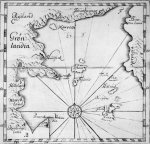I, Eyvindur: To the Land of Wine (Preface & Glossary)

By FabiandeKerck
- 339 reads
PREFACE
Under the Mongol Empire's hegemony over Asia, Europeans had long enjoyed a safe land passage – the Silk Road – to the Indies and China. Sources of valuable and exotic goods; spices, and silks, highly sought after in Europe. However, with the fall of Constantinople to Mehmed II and the Ottomans in 1453, that route to Asia was no longer safe. Portuguese navigators were amongst the first attempting to find a sea way to Asia. Much of this idea was built around sailing south, down the coast of Africa. A tenuous voyage.
In 1470, the Florentine astronomer Paolo dal Pozzo Toscanelli suggested to King Afonso V of Portugal that sailing west would be a quicker way to reach the Spice Islands, Cathay (China), and Cipangu (Japan) than the route around Africa.
In the 1480s, the Italian Cristoforo Colombo and his brother had picked up Toscanelli's suggestion. They proposed a plan to reach the Indies by sailing west across the "Ocean Sea" - the Atlantic.
Columbus travelled from Portugal to Genoa and to Venice, whilst his brother Bartholomew to the court of Henry VII of England, all to inquire about whether they might sponsor his expedition, all to no success.
Their final option came from the monarchs Ferdinand II of Aragon and Isabella I of Castile, who had united several kingdoms in the Iberian Peninsula through their marriage. After continually lobbying at the Spanish court and with two years of negotiations, Christopher finally found success in January 1492. The Moors had been driven from Spain. The sovereigns granted his funding. Columbus left for the first of four voyages later that year. In ensuing centuries, he is credited as discovering the Americas.
Columbus did not step foot on North American soil.
But even if he had, he was nearly 500 years too late.
Leif Eriksson, an Icelandic explorer, born between 970-980 AD as son to the infamous discoverer of Greenland, Erik the Red, captain of thirty-five companions, was amongst the first Europeans to have set foot on continental North America.
With his crew, Erik founded Vinland.

GLOSSARY
Vinland: “Wine Land”. Believed to have had wine grapes and wheat growing freely in the wild. Presumably includes both Newfoundland and the Gulf of Saint Lawrence as far as north-eastern New Brunswick.
Njól: night.
Ginnungagap: the bottomless abyss that was all there was prior to the creation of the cosmos. Following Ragnarök, everything should return to Ginnungagap.
Ragnarök: the cataclysm or apocalypse at the end of the current cycle of the world in ancient Norse mythology.
Miðgarðr: the name for Earth and/or the Plane in which humans inhabit in Norse mythology.
Hirð: (hird) household, family, retinue, court.
Vikin: Norse word for Viken, the historical name for a district in south-eastern Norway, including the modern-day Swedish province Bohuslän.
Helluland: “Land of Flat Stones/Rocks”. The first of three lands in North America visited by Eriksson. It is most likely Baffin Island, Canada.
Draumr: dreams.
Sea-whip: ancient Norse sea monster.
Lindwyrm: ancient Norse dragon, or a large serpent with two forelimbs, that lived in oceans and seas.
Selma: a large snake-like lake monster said to live in Lake Seljord in Norway.
Nix: Germanic water spirits.
Strandvasker: a drowned person washing up on the shore.
Draug: the spirit of a person who died at sea. If someone happens to see a draug, they are in mortal danger unless they race the draug and win.
Draugen: plural of draug.
Húskarl: Housecarl.
Þór: Thor, Aesir of Thunder in Norse mythology.
Markland: “Forest Land”. Part of the Labrador coast in Canada.
Valhöll: “Valhalla”. A majestic, enormous hall located in Asgard, ruled over by the god Odin. Chosen by Odin, half of those who die in combat travel to Valhalla upon death, led by Valkyries.
Asgard: the Plane of the Aesir.
Aesir: one of two pantheons (or tribes) of gods in Norse mythology. Includes Odin, Thor, Tyr, and Frigg.
Æsir: the Aesir gods.
Ásynjur: the Aesir goddesses.
Stíga: step.
Svartr: black, absorbs all light.
Yggdrasil: an immense mythical tree that plays a central role in Norse mythology and cosmology, where it connects the Nine Worlds/Planes of existence.
Skrælingjar: plural of Skraeling in Old Norse.
Skraeling: a name first applied to the Thule people, the proto-Inuit group with whom the Norse coexisted in Greenland. Further extended to apply to the natives of Vinland and Markland.
Younger Futhark: Younger Futhark, also called Scandinavian runes, is a runic alphabet and a reduced form of Elder Futhark, with only 16 characters.
- Log in to post comments


